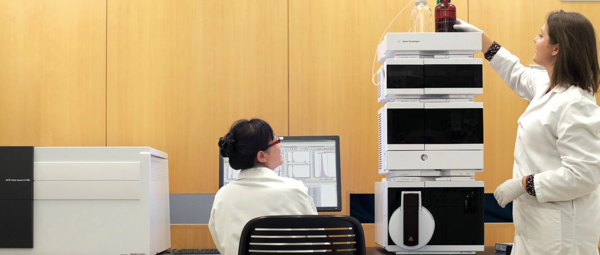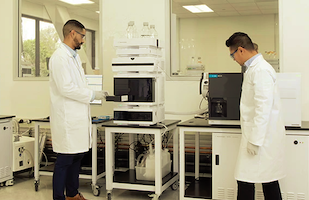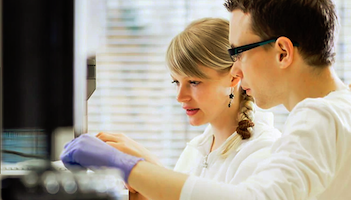Analytical Instrument Support
In addition to directly supporting pre-competitive research, Analytical Instrument Members (AIMs) are able to showcase the performance and capabilities of their products to both the commercial and academic parts of the CBM ecosystem. Recent examples include:
Agilent Triple Quadrupole LC/MS

As part of their commitment to CBM, Agilent has placed a top-of-the-line 6495C Triple Quadrupole LC/MS system in the lab of Professor Gaurav Chopra at Purdue, where it is being used for the group's CBM project on Machine Learning for Multiple Reaction Monitoring Mass Spectrometry. This research is being carried out in conjunction with Graham Cooks' lab, and other CBM projects have access to the instrument as well. “The new instrument is a godsend to our laboratory,” says Chopra, whose students received training and are sharing results with the Agilent team and other CBM industry members. The 6495C Triple Quad LC/MS is available for use on other CBM projects as well, and is available for evaluation to all CBM industry members. Please contact Professor Chopra with inquiries or visit the Agilent website to learn more.
Agilent G6230BA Time of Flight Mass Spectrometer

Agilent Technologies has also placed a state-of-the-art G6230BA Time of Flight Mass Spectrometer in the lab or Professor Mary Wirth at Purdue, where it is being used for the group’s CBM project on Chromatographic Resolution of Ultralarge Proteins. “The new instrument is awesome, giving us unprecedented ability to detect and characterize the species being resolved in our new chromatographic separations,” notes graduate student Tyrel Wagner, soon to complete his Ph.D. studies with Professor Wirth. Wagner received training from Agilent on use of the instrument, and he and other members of the Wirth group are sharing results with the Agilent team and other CBM industry members. As with other instruments loaned by the company, the G6230BA ToF MS is available for use on other CBM projects and can be evaluated by all CBM industry members. Contact Professor Wirth with inquiries or visit the Agilent website to learn more.
Agilent 7100 Capillary Electrophoresis instrument with MSD XT MS Detector

Agilent Technologies has placed two different instruments, an Agilent 7100 Capillary Electrophoresis Instrument and an Agilent MSD XT MS detector in the lab of Professor Matt Champion at Notre Dame, where they are being used for the group’s CBM project investigating an In-line cIEF-ESI-MS/MS Interface. “These new instruments are amazing, giving our group an ability to carry out these studies with unprecedented accuracy and performance,” Champion says. Students at Notre Dame have received training from Agilent on use of the instruments and the team is sharing results with researchers from Agilent and a number of other CBM member companies. Both the Agilent 7100 Capillary Electrophoresis Instrument and an Agilent MSD XT MS detector are available for use on other CBM projects and can be evaluated by all CBM industry members. Please contact Professor Champion with inquiries or visit the Agilent website to learn more.
CE/MS System

The Agilent CE/MS System comprises the Agilent 7100 CE System directly interfaced with any of the Agilent LC/MS systems. A range of ion sources, including standard ESI, can be installed, and additional detectors—such as UV-DAD, LIF, and CCD—can be operated parallel to MS. Agilent MassHunter software can be used to control the entire system from one workstation.
The system is the only single-vendor CE/MS solution on the market, seamlessly combining CE, MS, and software. CE/MS couples the short analysis times and high separation efficiencies of CE with the molecular weight and structural data gained from MS.
Features
- Can be interfaced with all Agilent LC/MS systems
- Excellent MS sensitivity through high-efficiency desolvation systems
- 'Plug and play' spraying system needs no positional adjustments, enabling very simple and stable operation and allowing the use of moderate amounts of conventional electrophoretic buffers
- Nebulizer operating at ground potential makes CE separation conditions independent from MS operation conditions
- Multiple ionization sources are available (e.g., standard ESI or Agilent Jet Stream Electrospray sources), APCI, and APPI
- The only single-vendor CE/MS solution assures best possible support, ease-of-use, and reliability